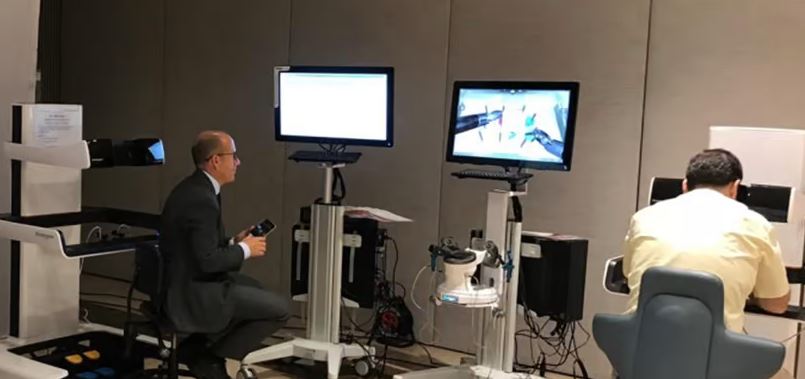Pyramid propels University of Pretoria to even greater student success
Customer Company Size
Large Corporate
Region
- Africa
Country
- South Africa
Product
- Pyramid Decision Intelligence Platform
- Blackboard Analytics for Learn
- PeopleSoft Student Information System
Tech Stack
- Amazon Web Services (AWS)
- Blackboard Learning Management System (LMS)
- Higher Education Data Analyzer (HEDA)
Implementation Scale
- Enterprise-wide Deployment
Impact Metrics
- Productivity Improvements
- Customer Satisfaction
- Digital Expertise
Technology Category
- Analytics & Modeling - Predictive Analytics
- Application Infrastructure & Middleware - Data Visualization
- Platform as a Service (PaaS) - Data Management Platforms
Applicable Industries
- Education
Applicable Functions
- Quality Assurance
- Business Operation
Use Cases
- Remote Collaboration
Services
- Cloud Planning, Design & Implementation Services
- Data Science Services
- System Integration
About The Customer
The University of Pretoria (UP) is a multi-campus public research university located in South Africa. It is one of Africa’s top universities, teaching over 50,000 students across seven campuses. The university boasts an 83.5 percent pass rate and 93 percent of its graduates are employed within six months of qualifying. UP is committed to improving student success rates and has implemented an evidence-based approach to support its strategic goal of enhancing student access and success. The university uses student data to intervene in a timely manner if a student is underperforming. UP has a strong focus on data-driven strategies and has integrated various data sources to provide a holistic view of student performance and institutional operations.
The Challenge
The University of Pretoria (UP) is a multi-campus public research university in South Africa, teaching over 50,000 students across seven campuses. With an 83.5 percent pass rate and 93 percent of graduates employed within six months of qualifying, UP is one of Africa’s top universities. On a mission to further improve student success rates, the UP was looking to advance its analytics capabilities. “We implemented an evidence-based approach to support our number one strategic goal to improve student access and success, therefore using student data to intervene in time, not after the fact, if a student is underperforming,” explained Dolf Jordaan, Deputy Director of eLearning. “We needed an integrated cloud-based solution data eco-system in our approach to improving student success—you can’t just put words on strategic documents focusing on student success without using data.” Analytics from the Blackboard Learning Management System (LMS), which both students and lecturers use, provided reports on each course and numerous performance course reports to help identify students who were at risk of falling behind. But a more holistic institutional view was needed, one that could pull in other data sources, including an institutional resource of historical data used for national reporting, student surveys, and the PeopleSoft Student Information system that held campus data. When some systems and data sources were migrated to the cloud with Amazon Web Services, there was an opportunity to develop a more sophisticated scalable approach. The goal was to provide Faculty Student Advisors and other key stakeholders with an intelligence platform for digging deeper into descriptive and predictive analytics. As a Blackboard partner, the Pyramid platform was a natural fit for UP in 2013.
The Solution
The Pyramid Decision Intelligence Platform combines data preparation, analytics, and data science, which were key areas UP aimed to improve. As the first African higher education institution to implement Blackboard Analytics for Learn, UP was ready to build on its capabilities. Pyramid, being a Blackboard partner, was well-positioned to supplement course analytics from the LMS with a holistic institutional view, drawing on other data sources. Pyramid’s Pulse engine enables UP to pursue a hybrid approach, pulling in data from both cloud and on-premises databases. Data modeling features integrate Blackboard, PeopleSoft, Higher Education Data Analyzer (HEDA), and Student Academic Readiness Surveys (STARS) for granular analysis. Combining historical and real-time data on the Pyramid platform means descriptive insights on grades and course activity are now supplemented with cohort analytics that can be used to identify students at risk. The flexibility to model more data sets was matched by a license that covered 250 active users and allowed for report bursting, where reports not dynamically tied to underlying data can be created, scaled, and made available to stakeholders, including deans, deputy deans, and heads of department. Modeling in Pyramid has been fundamental for helping the executive leadership team, for example, informing the executive leadership through real-time data during the COVID-pandemic, and reporting the university’s teaching and learning performance to national stakeholders.
Operational Impact
Quantitative Benefit

Case Study missing?
Start adding your own!
Register with your work email and create a new case study profile for your business.
Related Case Studies.

Case Study
IoT platform Enables Safety Solutions for U.S. School Districts
Designed to alert drivers when schoolchildren are present, especially in low-visibility conditions, school-zone flasher signals are typically updated manually at each school. The switching is based on the school calendar and manually changed when an unexpected early dismissal occurs, as in the case of a weather-event altering the normal schedule. The process to reprogram the flashers requires a significant effort by school district personnel to implement due to the large number of warning flashers installed across an entire school district.

Case Study
Revolutionizing Medical Training in India: GSL Smart Lab and the LAP Mentor
The GSL SMART Lab, a collective effort of the GSL College of Medicine and the GSL College of Nursing and Health Science, was facing a challenge in providing superior training to healthcare professionals. As clinical medicine was becoming more focused on patient safety and quality of care, the need for medical simulation to bridge the educational gap between the classroom and the clinical environment was becoming increasingly apparent. Dr. Sandeep Ganni, the director of the GSL SMART Lab, envisioned a world-class surgical and medical training center where physicians and healthcare professionals could learn skills through simulation training. He was looking for different simulators for different specialties to provide both basic and advanced simulation training. For laparoscopic surgery, he was interested in a high fidelity simulator that could provide basic surgical and suturing skills training for international accreditation as well as specific hands-on training in complex laparoscopic procedures for practicing physicians in India.

Case Study
Implementing Robotic Surgery Training Simulator for Enhanced Surgical Proficiency
Fundacio Puigvert, a leading European medical center specializing in Urology, Nephrology, and Andrology, faced a significant challenge in training its surgical residents. The institution recognized the need for a more standardized and comprehensive training curriculum, particularly in the area of robotic surgery. The challenge was underscored by two independent studies showing that less than 5% of residents in Italian and German residency programs could perform major or complex procedures by the end of their residency. The institution sought to establish a virtual reality simulation lab that would include endourological, laparoscopic, and robotic platforms. However, they needed a simulator that could replicate both the hardware and software of the robotic Da Vinci console used in the operating room, without being connected to the actual physical console. They also required a system that could provide both basic and advanced simulation training, and a metrics system to assess the proficiency of the trainees before they performed surgical procedures in the operating theater.

Case Study
Edinburgh Napier University streamlines long-distance learning with Cisco WebEX
• Geographically dispersed campus made in-person meetings costly and inconvenient.• Distance-learning programs in Malaysia, India, and China required dependable, user-friendly online tools to maximize interaction in collaborative workspaces.• Virtual learning environment required a separate sign-in process, resulting in a significant administrative burden for IT staff and limited adoption of collaboration technology.

Case Study
8x increased productivity with VKS
Before VKS, a teacher would spend a lot of time showing a group of 22 students how to build a set of stairs within a semester of 120 hours. Along with not leaving the teacher much time to provide one-on-one support for each student to properly learn carpentry, it also left a considerable amount of room for error. Key information would be misinterpreted or lost as the class was taught in the typical show-and-tell way.

Case Study
Scalable IoT Empowering GreenFlex's Sustainable Growth
GreenFlex, a company that supports sustainable development, decarbonization, and energy efficiency, faced several challenges in its quest to expand its business. The company needed to deploy a robust and sustainable IoT technology to support its growth. It was crucial for them to monitor and control devices at customer sites in a safe and reliable manner. They also needed to integrate devices across a range of communication protocols and gather and act on data to meet efficiency targets. GreenFlex had previously built IoT capabilities into its digital platform, GreenFlexIQ, to monitor and manage customer sites remotely. However, they soon realized that they needed a new platform to support their ambitions. They needed a platform that could scale to connect more devices for production management and make it easier for the operations team to manage devices in the field.


